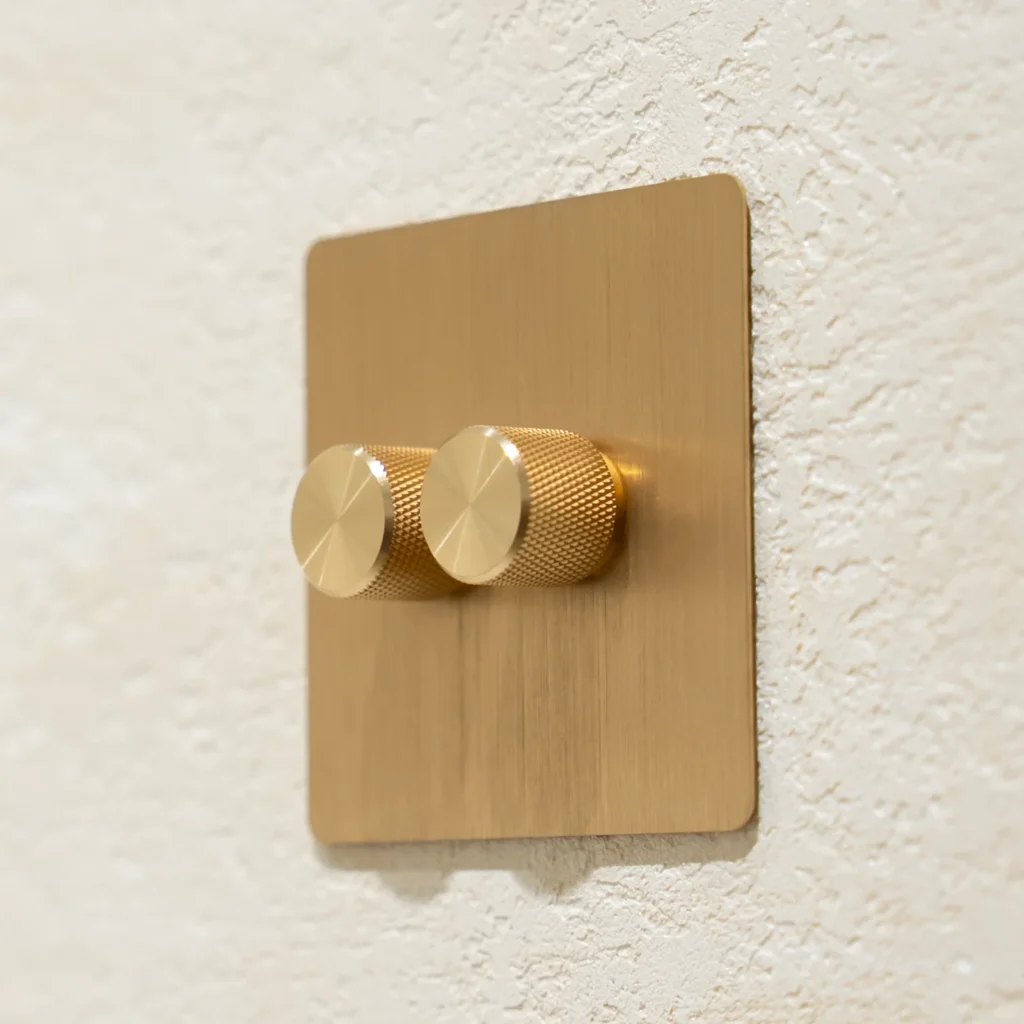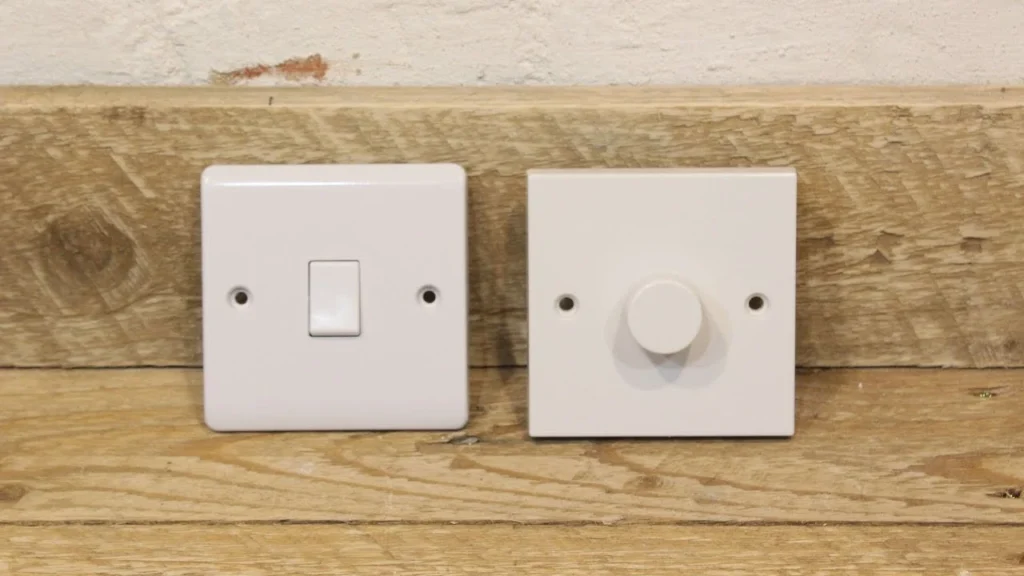
Elevate your UK home with a revolutionary approach to wall controls. Discover how designer rotary dimmers and their identical ‘dummy’ switch counterparts create perfect visual symmetry for a truly unified, luxury look.
Table of Contents
You’ve poured your heart, soul, and a significant budget into your home renovation. Weeks have been spent deliberating over the perfect shade of Farrow & Ball paint. The flooring is ideal, the kitchen cabinetry is a work of art, and yet, a jarring note quietly undermines the entire aesthetic.
Glance at your walls. It’s a scene familiar in countless British homes: a standard white plastic rocker switch sits awkwardly beside a differently-sized, and often differently-styled, rotary dimmer. This fundamental clash of form is perhaps the most common design crime committed on our walls. While each performs its function, together they create visual clutter, a series of small but significant distractions that detract from the cohesive vision you’ve worked so hard to achieve.
It’s an issue often overlooked until the final stages, but it’s one that can truly make or break the final, polished look.

It’s time for a paradigm shift. We must move beyond seeing these everyday objects as mere functional necessities and start viewing them as the finishing touch, the ‘jewellery’ for your walls. The transition from a basic utility item to a designer control is arguably one of the most cost-effective yet impactful upgrades you can make.
These are not just switches, they are crucial tactile points you and your guests interact with daily. Consider the satisfying, solid rotation of a finely knurled brass dimmer knob. Now imagine that same, deeply satisfying tactile experience for every single light control in your room (The dimmer features a press-and-rotate knob, whereas the dummy dimmer’s knob is press-only.). This haptic feedback—the feeling of quality under your fingertips—contributes to a subconscious sense of luxury and permanence, much like the reassuring weight of a quality door handle. Investing in luxury light fittings is an investment in the overall sensory experience of your home.
Achieving a polished, high-end look hinges on creating a consistent design narrative, and your choice of finish is the protagonist. Selecting a single, high-quality finish for all your controls creates a powerful, unifying visual language. In the UK, several palettes are consistently favoured for their style and versatility:
Antique & Satin Brass: The undisputed champion of classic-contemporary design. Brass light switches offer a timeless warmth that works beautifully in period properties, yet they feel equally at home in modern shaker kitchens, pairing exquisitely with the deep blues, greens, and rich greys popular in British interiors.
Matt Black: For a bolder, more contemporary statement, a black dimmer switch is an unparalleled choice. It provides a dramatic, graphic contrast against light or textured walls, making it a cornerstone of industrial, minimalist, and ‘Japandi’ aesthetics.
Brushed stainless steel: These silvery tones offer cool, crisp sophistication. They are a go-to for modern bathrooms and sleek kitchens, creating a clean, cohesive, and thoroughly contemporary feel.
White Metal: For the ultimate minimalist, a white metal switch on a white wall creates a subtle, textural, and almost seamless look, perfect for serene, Scandinavian-inspired spaces.
So, you’ve settled on a stunning satin brass finish. The real challenge begins now. This is where most design visions are forced into a compromise, not just on finish, but on form.
The core issue isn’t just finding a matching dimmer and light switch from a colour chart. The true design crime is the fundamental mismatch in control type. On one side, you have the elegant, rotary motion of a dimmer. On the other, the functional, but visually disruptive, click of a toggle or a rocker switch. Placed side-by-side on a multi-gang plate, they create a jarring visual dissonance, an admission that form has surrendered to function.
This problem is magnified on an aesthetic multi-gang light switch panel. A kitchen island might demand a dimmer for overhead spotlights and a simple switch for decorative pendants. The result? A panel of mismatched controls – a knob here, a rocker there – that breaks the clean, symmetrical vision you’ve worked so hard to achieve. Until now, achieving true uniformity felt impossible.
Thankfully, a revolutionary approach has emerged to solve this core aesthetic challenge. The solution lies not in trying to find a rocker switch that vaguely matches a dimmer, but in reimagining the switch itself.
Welcome to the concept of the ‘Dummy Dimmer’.
Forward-thinking brands like Repenic have engineered a simple yet brilliant solution: a control that looks and feels exactly like a high-end rotary dimmer, but internally functions as a simple on/off switch.
This means you can now specify a complete suite of controls with absolute visual confidence. You can place a true rotary dimmer for your main lights right next to a ‘dummy’ dimmer for your accent lights. For a three-gang plate, you could have one true dimmer and two ‘dummy’ switches. To the eye and to the touch, they are identical. They all share the exact same backplate, material, finish, and the signature knurled knob.
This system is a paradigm shift for anyone undertaking a serious home renovation. It finally allows for absolute symmetry and visual consistency across all your control points, eliminating the aesthetic compromise between function and form. It’s the secret to achieving that truly clean, uncluttered, and high-end vision.
In the world of interior design, excellence is achieved in the final one per cent. It is the meticulous attention to detail that elevates a project from ‘finished’ to ‘flawless’. Your light controls are not minor details; they are some of the most frequently used, most visible elements in your home.
Choosing to unify them with an identical aesthetic is more than a simple upgrade. It’s an affirmation of your commitment to absolute visual symmetry and a cohesive design philosophy. It’s an investment in the tactile pleasure of quality and a daily reminder that you didn’t have to compromise on your vision. It is the secret weapon that ensures your home not only looks beautiful but feels exceptional, right down to the very last control.
You no longer need to accept the visual compromise between a switch and a dimmer. The solution to creating a truly harmonious and symmetrical interior is here. If you’re ready to banish mismatched controls and elevate your space, the next step is simple.
Explore the Repenic collection today to discover the full range of finishes and functions, and find the perfect combination to complete your home’s unique design story.

Product manager at Repenic
Want your home to outshine the neighbours?
We’ll drop you the occasional tip on how to do just that.
No spam. Just style inspiration.
By clicking “Subscribe” I consent to receiving commercial information to the above e-mail and to having my data processed in connection with the newsletter.